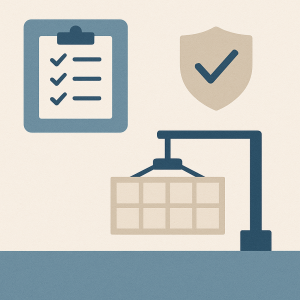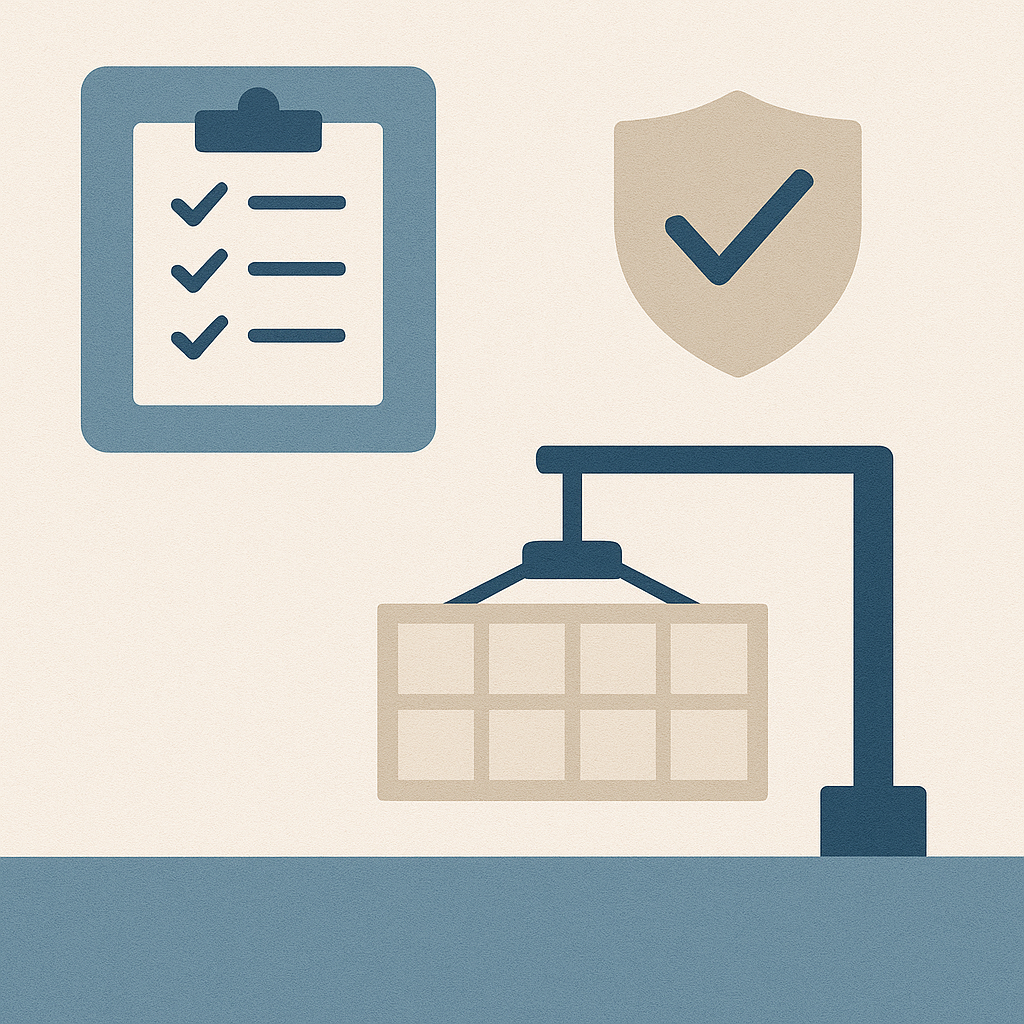Ensure cargo safety, structural integrity, and regulatory compliance with this expert guide to the top 12 things to check after cargo completion on container ships. Learn best practices, safety protocols, and real-world applications for modern maritime operations.
Why Post-Cargo Completion Checks Matter
The moment cargo operations are completed on a container ship is not the time to relax. In fact, this is when the responsibility for safety, compliance, and seaworthiness intensifies. For ship officers, port supervisors, cargo planners, and marine surveyors, ensuring all systems are in check before departure is critical. Any oversight can result in catastrophic consequences, from cargo damage and regulatory penalties to loss of stability or environmental incidents.
Modern container ships, with capacities exceeding 24,000 TEUs and equipped with automated lashing systems, present both opportunities and complexities. Post-cargo completion checks are not just routine—they are strategic safeguards rooted in SOLAS, ISM Code, Port State Control (PSC) expectations, and best practices from IMO, IACS, and classification societies like DNV or Lloyd’s Register.
This article unpacks the 12 most critical post-cargo checks—blending technical insight, real-world experience, and compliance-driven guidance.

Verify Cargo Securing and Lashing Integrity
Once cargo operations end, visual and manual verification of lashing becomes top priority. According to the IMO Cargo Securing Manual (CSM) and STCW training guidelines, improper or loose lashings are a major risk in rough seas.
Real-world incident reports from the Maritime and Coastguard Agency (MCA) and MAIB cite numerous container losses due to inadequate lashing checks—particularly on upper tiers and during multi-port rotations. Use torque wrenches where applicable, ensure lashings are per stack weight, and confirm corner castings are aligned.
Sources:
Reconfirm Stability, Trim, and GM Parameters
Stability isn’t static; it evolves with cargo distribution. Before departure, verify the GM (metacentric height), trim, and draft using updated cargo and ballast data.
The ClassNK Trim Optimization Guidance and ABS loading software recommendations highlight the use of onboard software like LOADMASTER or MACS3. But manual cross-checking—especially in critical weather conditions or after heavy lifts—is good seamanship.
Case Study: The 2018 loss of the MSC Zoe led to an EU investigation recommending stricter monitoring of stack weights and transverse stability margins in heavy seas.
Sources:
Inspect Hatch Covers and Weather Tightness
Your hatch covers are your shield against the sea. Use chalk tests or ultrasonic tightness devices to verify that no water can ingress.
Wärtsilä and MacGregor both supply modern hatch cover sealing systems with sensors, yet manual checking remains standard, especially on older vessels. Look for missing gaskets, deformed coamings, or improperly seated cross joints.
Regulatory Reference: SOLAS Chapter II-1 (Construction – Subdivision and Stability, Machinery and Electrical Installations)
Sources:
Final Check of Reefer Connections and Temperature Logs
Container ships today routinely carry hundreds of reefer containers—some stacked five or six tiers high. Misconnection or temperature fluctuations during or after loading can lead to spoilage, insurance claims, or even legal disputes.
Ensure:
- Every reefer plug is correctly connected
- Temperature logs are downloaded and aligned with cargo manifest
- Alarm systems for power interruptions are functional
Best Practice: Conduct a checklist with the reefer technician and chief officer using an ICS-endorsed reefer monitoring protocol.
Sources:
- International Chamber of Shipping (ICS) Guidelines
- Carrier Operation Manuals (e.g., Carrier Transicold)
Confirm Cargo Manifest and Documentation Accuracy
An overlooked discrepancy in the cargo manifest, dangerous goods declaration, or BAPLIE files can delay port clearance or trigger fines under Port State Control.
Work closely with the ship’s agent and port terminal operator to verify:
- The final number of loaded containers matches the manifest
- DG cargo segregation is correct
- Overstowed containers are updated in the bay plan
Digital Support: Use of EDI systems, CargoSmart, or NAVIS N4 terminals reduces manual errors and synchronizes with customs platforms.
Sources:
Conduct Pre-Sailing Safety Round
A ship isn’t ready to sail just because the cranes stop moving. A structured pre-departure safety inspection, guided by ISM Code Section 7, helps ensure the ship is secure and compliant.
Inspections should include:
- Water-tight doors
- Fire doors and detection systems
- Lifeboats and embarkation areas
- Navigational bridge readiness
Tool: Use an SMS checklist verified by the Safety Officer and Master. Port State Control officers often request this.
Sources:
Test Navigational Equipment and ECDIS Update
Your navigation systems should be 100% functional before you even request pilot boarding. This includes:
- Radar and ARPA
- AIS and VDR
- Gyro repeaters
- Updated ECDIS charts
Use Bridge Resource Management (BRM) techniques to check alarm settings and waypoints.
Real-World Note: Multiple detentions in PSC inspections are due to out-of-date ENCs or improperly calibrated radars.
Sources:
Check Hull and Propulsion Space for Debris or Obstructions
After busy cargo ops, it’s not uncommon to find loose items or FOD (Foreign Object Debris) in scuppers, steering gear rooms, or machinery space.
A full round of:
- Bilge inspections
- Overboard discharge checks
- Rudder clearance
…helps ensure nothing compromises ship maneuverability or leads to oil pollution.
MARPOL Reminder: Oily water separators and overboard valves should be locked and sealed per MARPOL Annex I before sailing.
Sources:
Ballast System Readiness and Exchange Planning
Especially when shifting from port to sea, your ballast water management plan must be ready and compliant.
Check:
- Ballast levels and heel
- Ballast exchange plans (if en route)
- System alarms and filter backwash records
Post-2020, ships must carry an approved Ballast Water Treatment System (BWTS) in accordance with the BWM Convention. Confirm functionality.
Sources:
Reconfirm VGM and Load Line Compliance
The Verified Gross Mass (VGM) requirement is not a formality. Any mismatch between actual container weight and declared VGM affects stability and legal compliance.
Cross-check VGM entries with final stowage plans. Ensure:
- Draft marks are readable
- Load line immersion is within limits
- Load line certificate is valid onboard
Reference: SOLAS Chapter VI, Regulation 2
Sources:
Secure Deck and Navigational Areas from Unintended Movement
After cargo ops, loose mooring lines, dunnage, or tools may remain on deck. These become hazards once the ship sails.
Secure:
- Ladders, lashings, gangways
- Mooring winch brakes
- Bosun stores and access points
The International Safety Guide for Container Ships (ISGICS) emphasizes a clean deck policy post-operations.
Sources:
Complete Master’s Departure Checklist and Notify All Stations
Finally, the Master must sign off on all operational readiness and inform:
- Engine room
- Deck watch
- Port control and VTS
This includes filling in the departure checklist, notice to port authorities, and pilotage arrangements. Communication protocols should be in line with IMO SMCP (Standard Marine Communication Phrases).
Sources:
- IMO SMCP
- [Local VTS Guidelines (Port Authority Specific)]
FAQ: Common Questions on Post-Cargo Checks for Container Ships
Why are post-cargo checks crucial? They ensure the vessel is safe, seaworthy, compliant with regulations, and ready to sail without incident.
Who is responsible for lashing verification? The chief officer, along with the deck crew and stevedores, must jointly inspect and confirm all lashings.
What’s the risk of inaccurate VGM reporting? It can destabilize the vessel, lead to stack collapses, and cause heavy fines from port authorities.
Are reefer containers automatically monitored? Modern ships use automated alarms, but manual checks are still necessary.
What document governs ballast water regulations? The Ballast Water Management (BWM) Convention, enforced by IMO.
Conclusion: Getting It Right Before the Sea Takes Over
Post-cargo completion is not a final step; it’s the start of safe navigation. The top 12 checks outlined here are more than tick-box items. They are life-saving, cargo-preserving, regulation-compliant measures that form the backbone of responsible seamanship.
For ship officers, knowing your gear is secure, your ship is balanced, and your systems are ready is the kind of quiet confidence that defines true maritime professionalism.
As global trade volumes rise and container ship sizes grow, these checks will become even more critical. Stay vigilant. Follow procedures. And never underestimate the sea.
References
- IMO Cargo Securing Manual
- SOLAS VI/2 Verified Gross Mass
- MAIB Investigation Reports
- ICS Reefer Guidelines
- DNV Technical Guidelines
- IMO ISM Code
- IHO ENC Standards
- Alfa Laval BWTS Systems
- ClassNK Maritime Safety Resources
- Wärtsilä Marine Systems
- Paris MoU Port State Control
- UNCTAD Port Logistics
- IMO SMCP Communication

